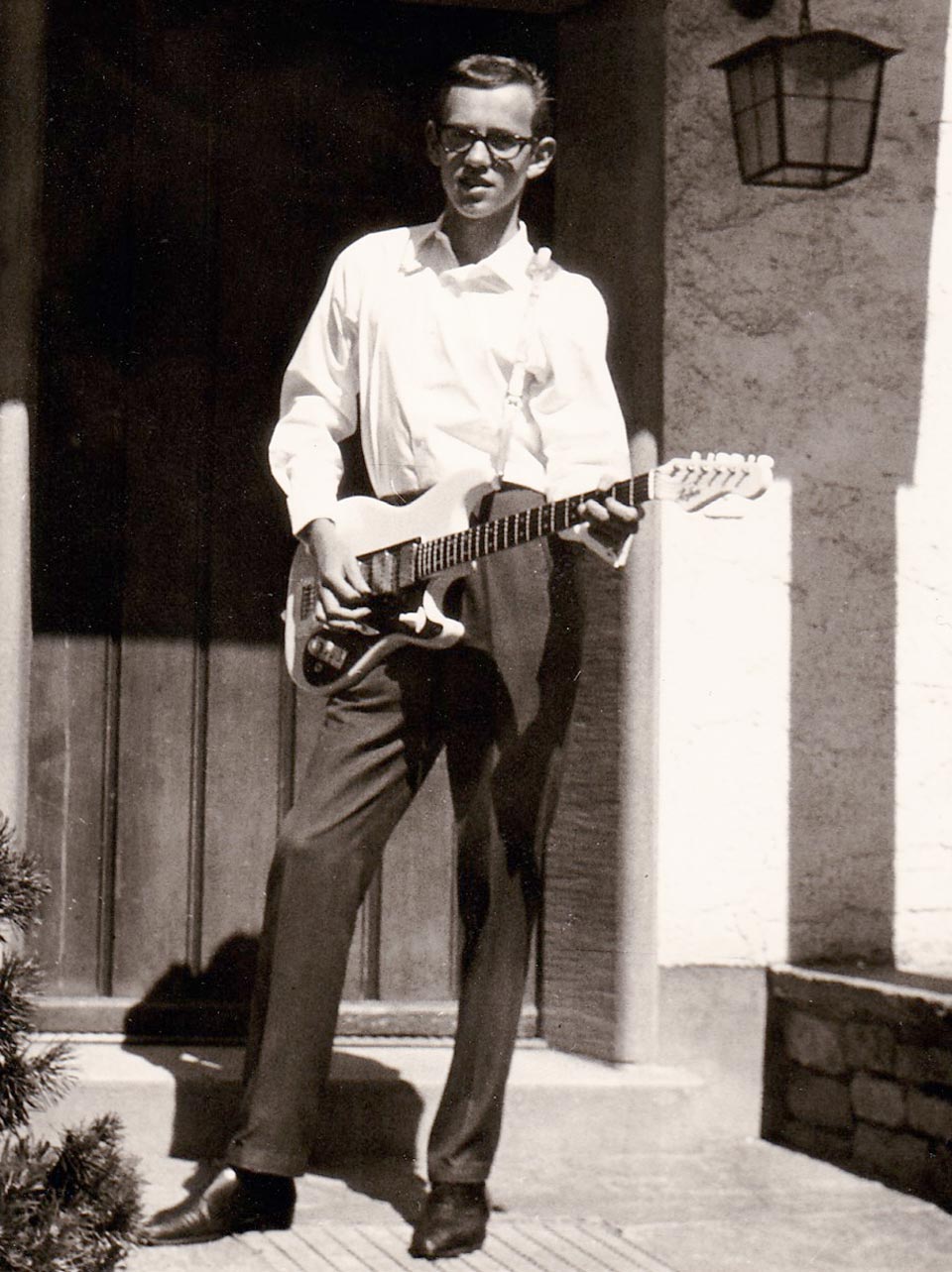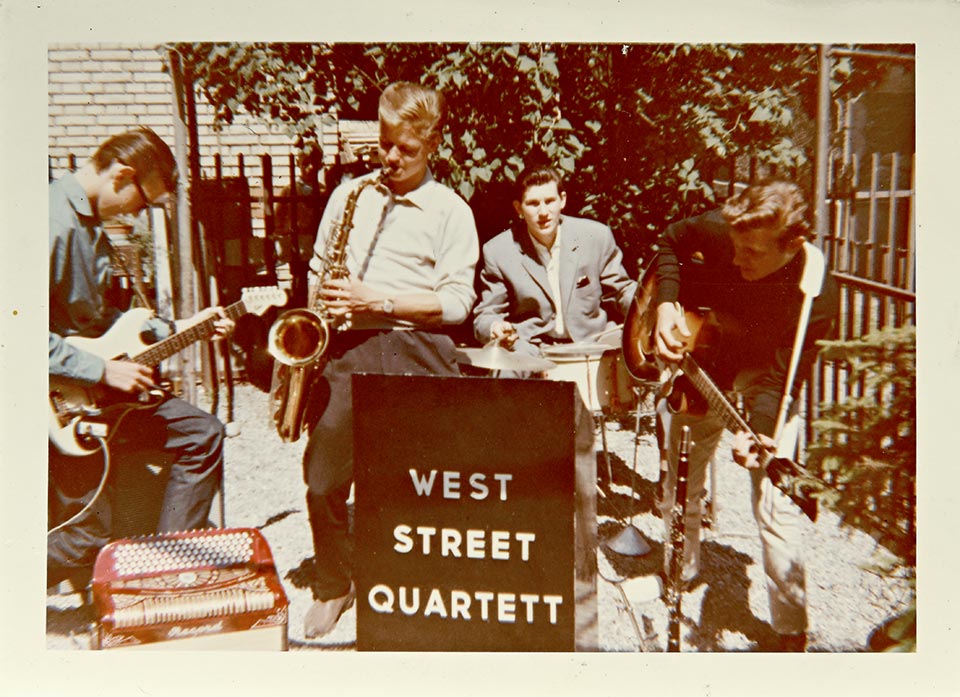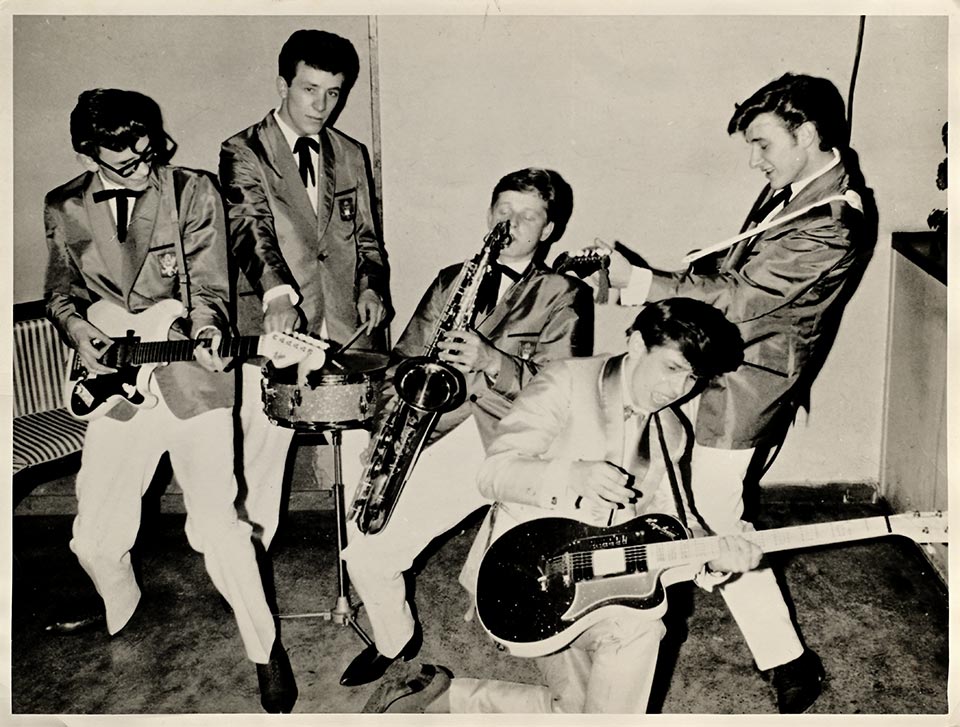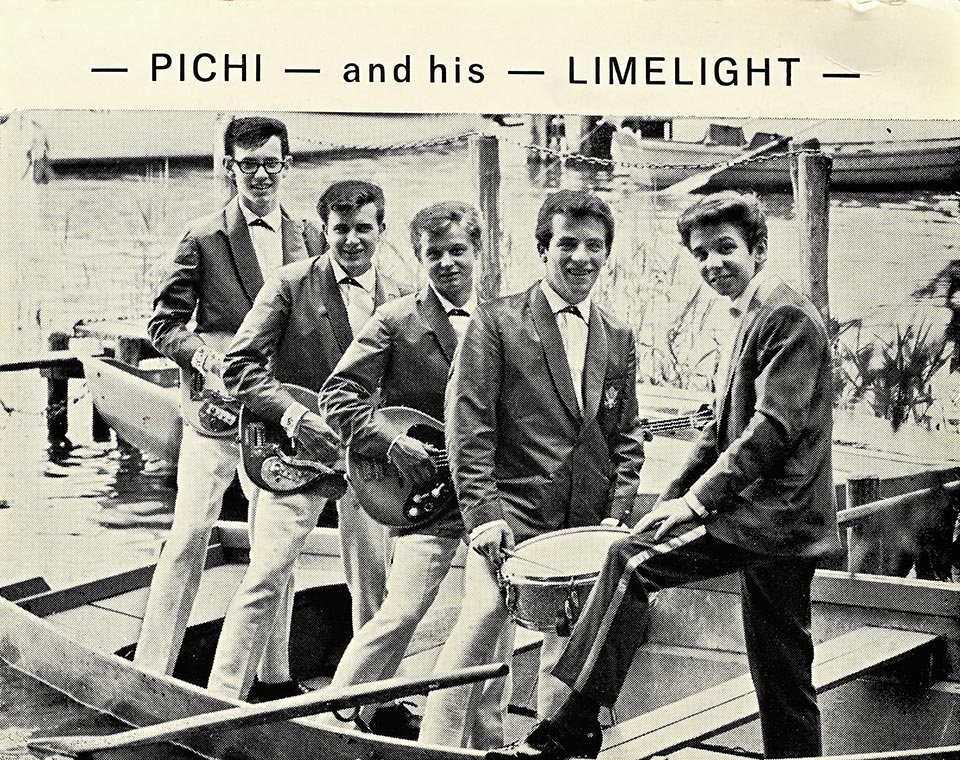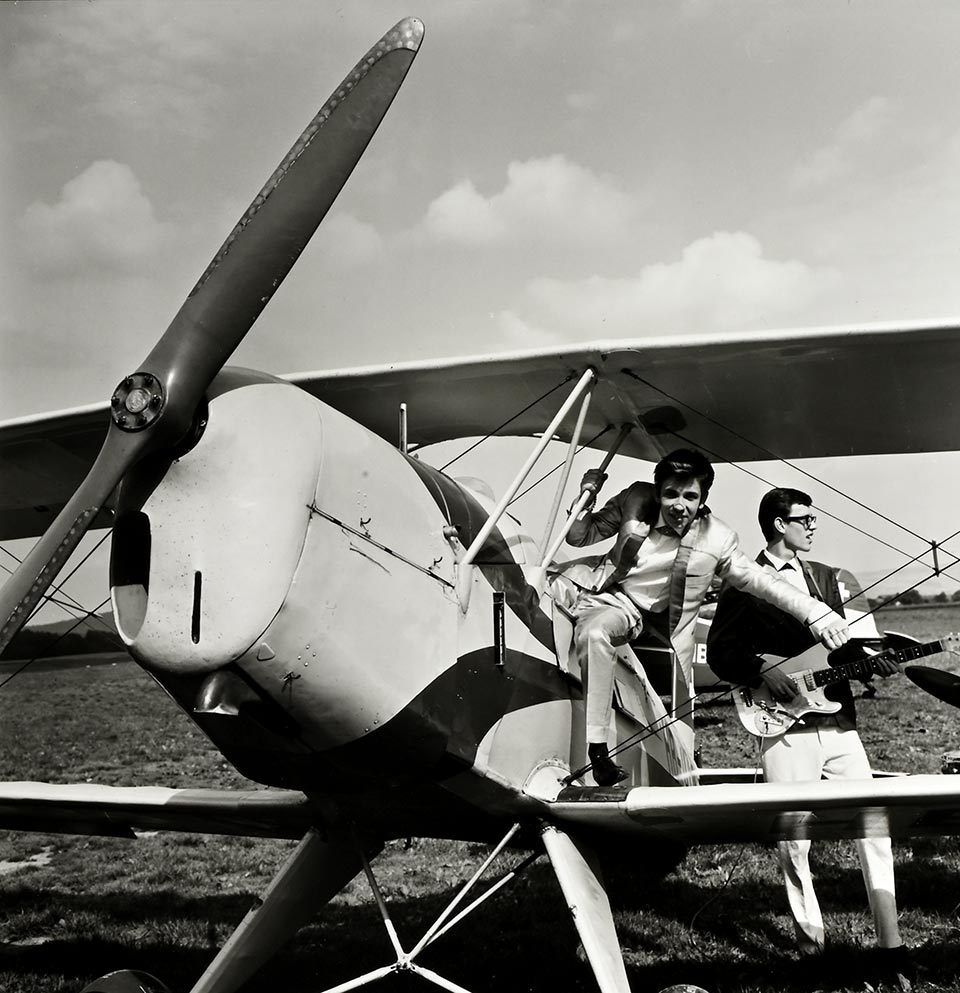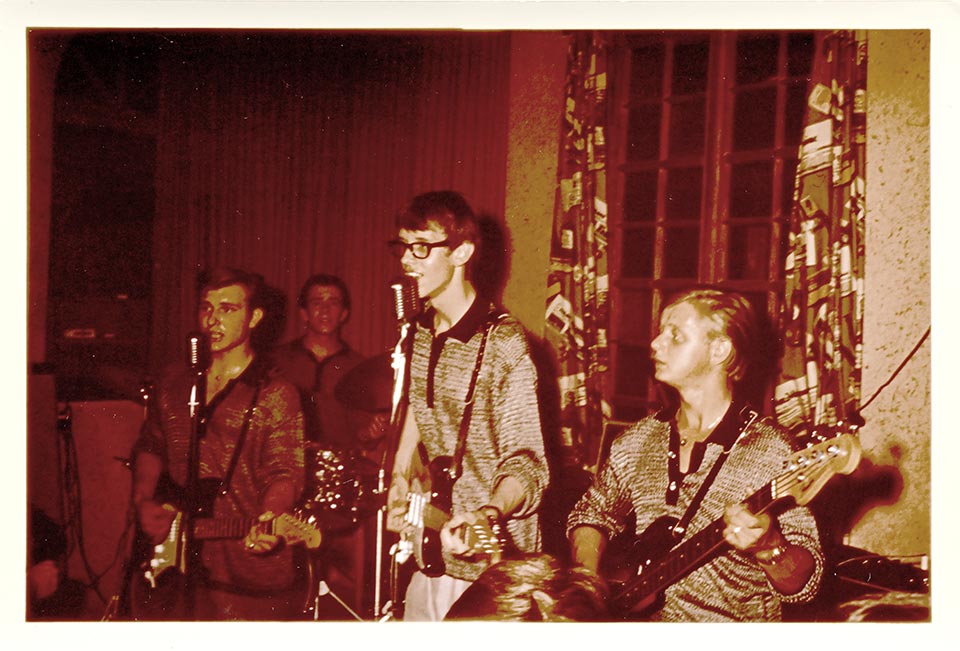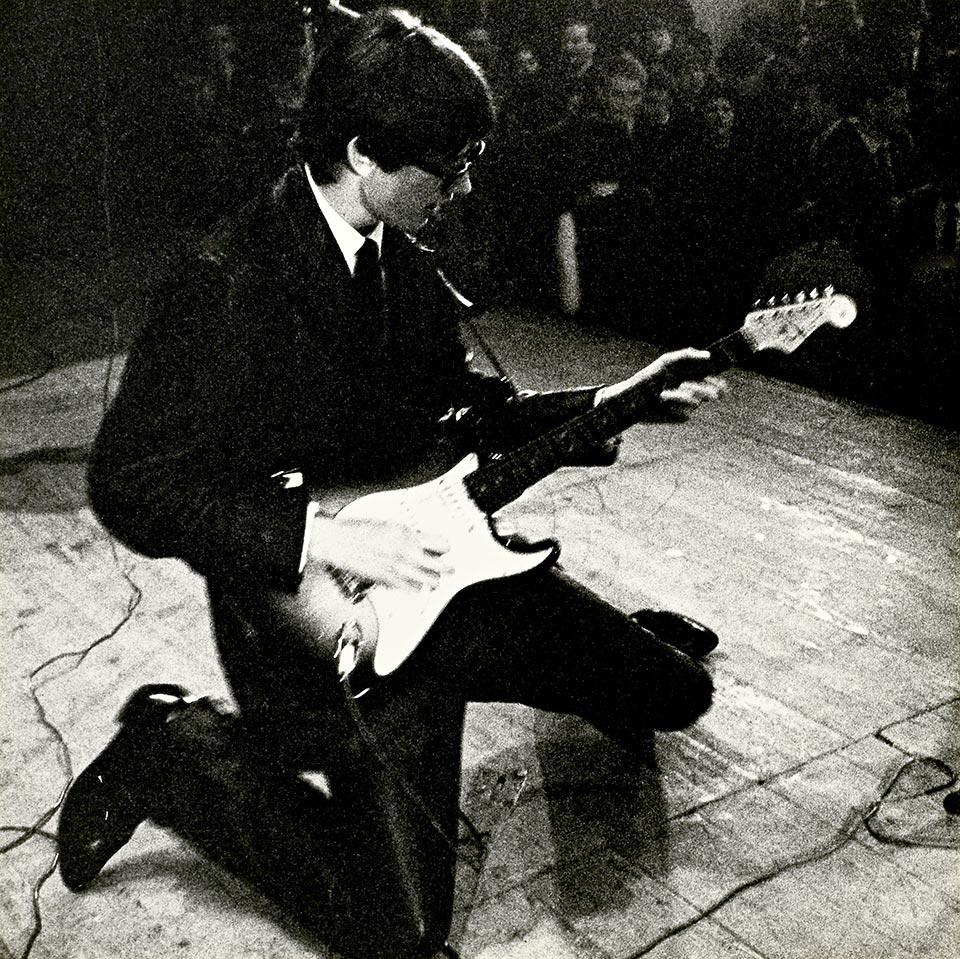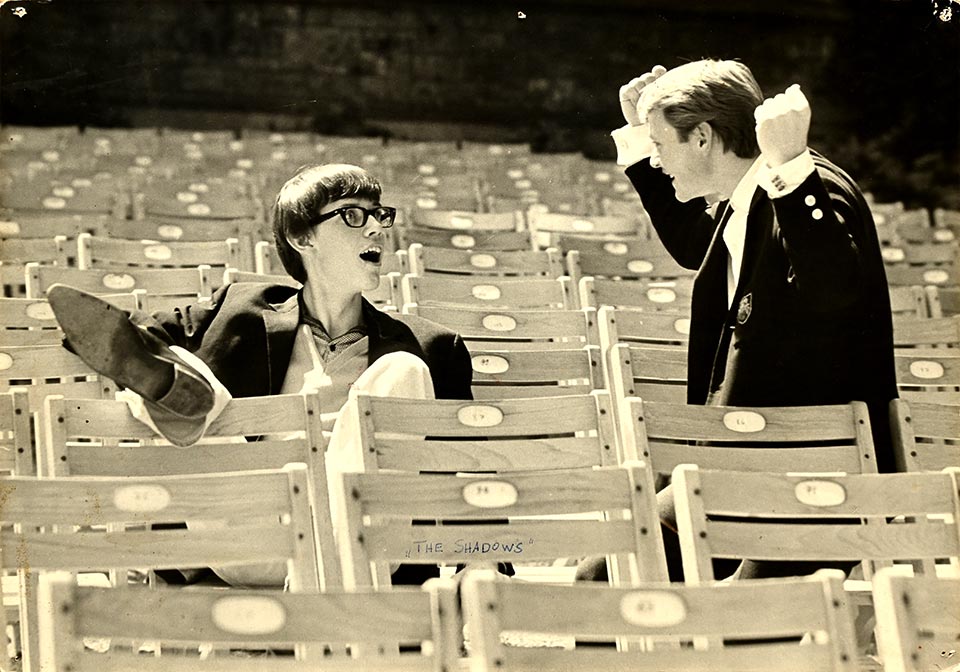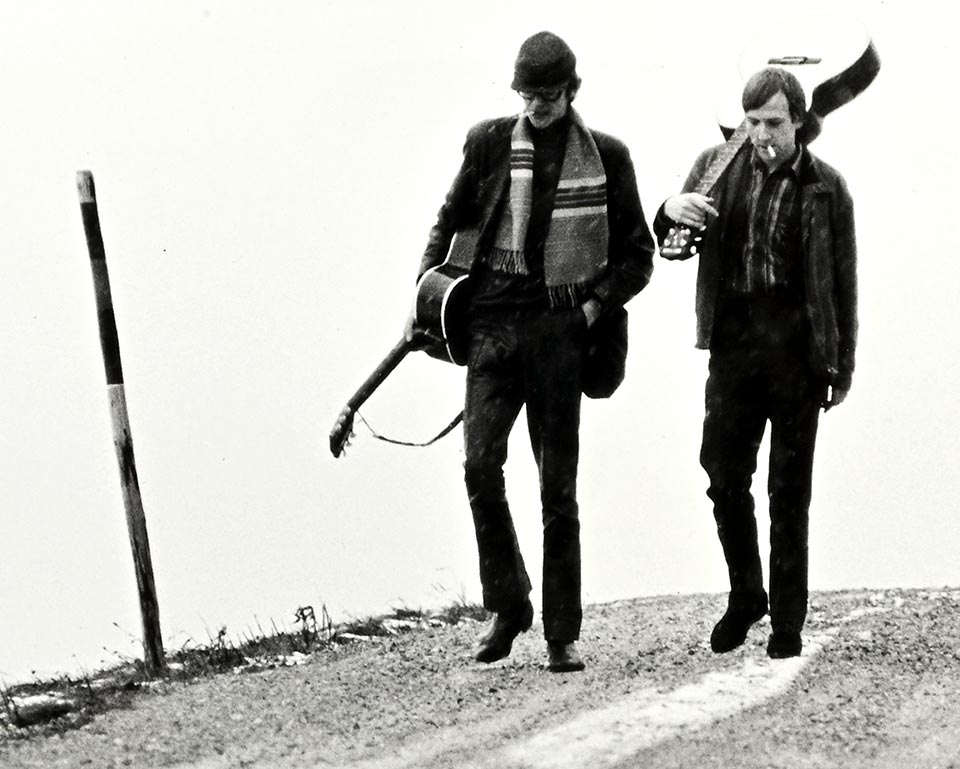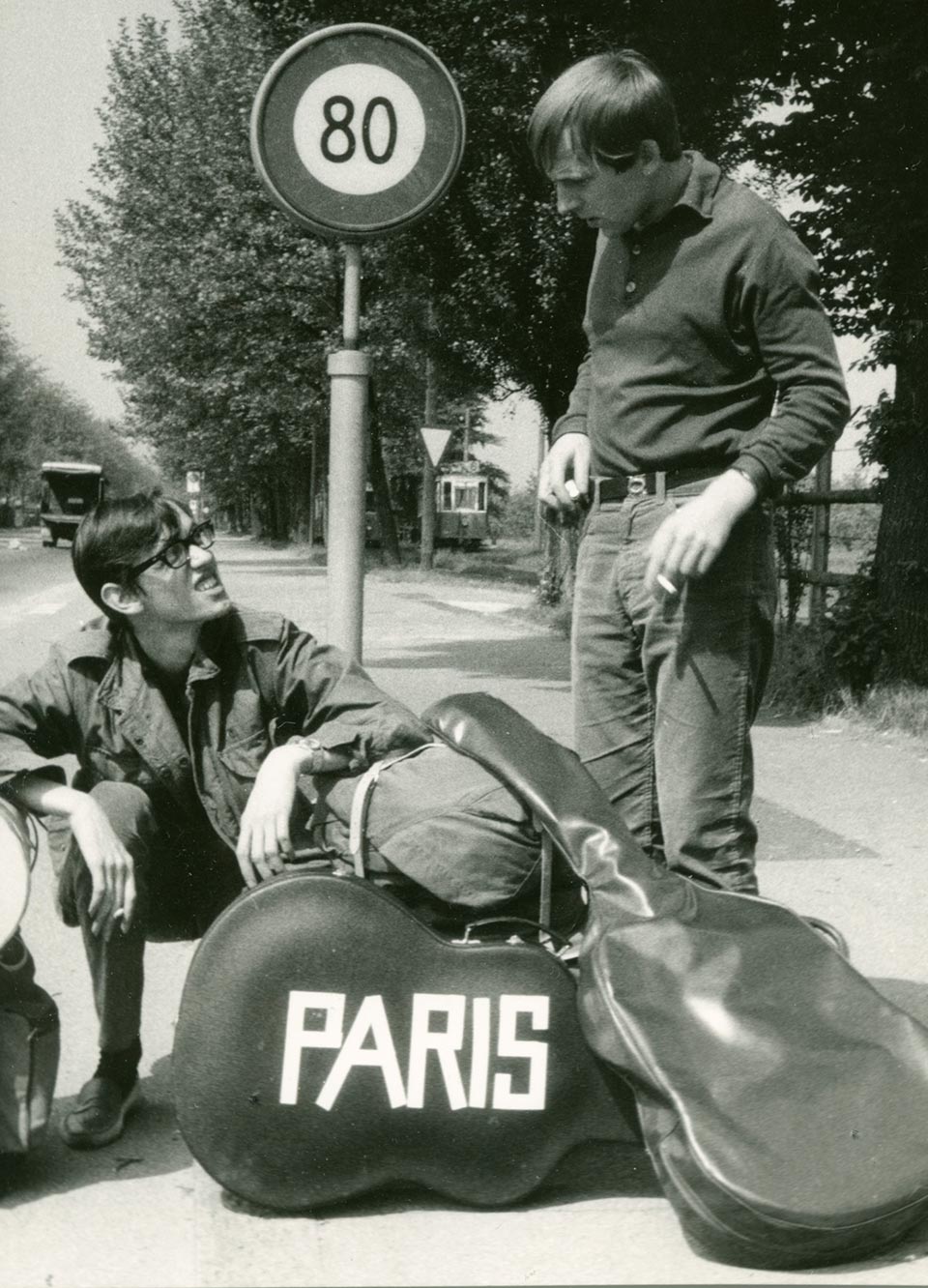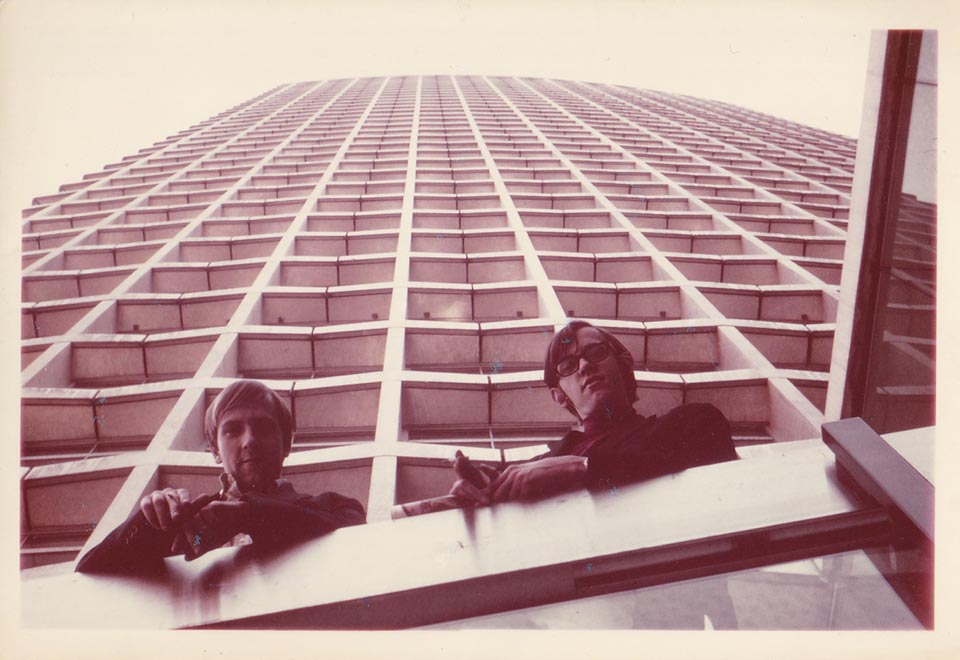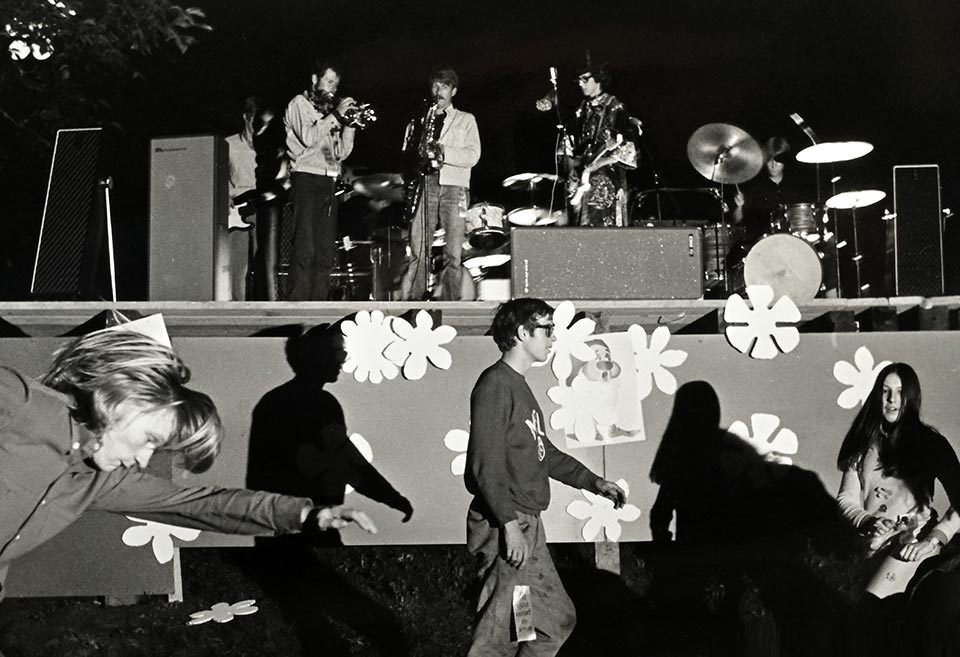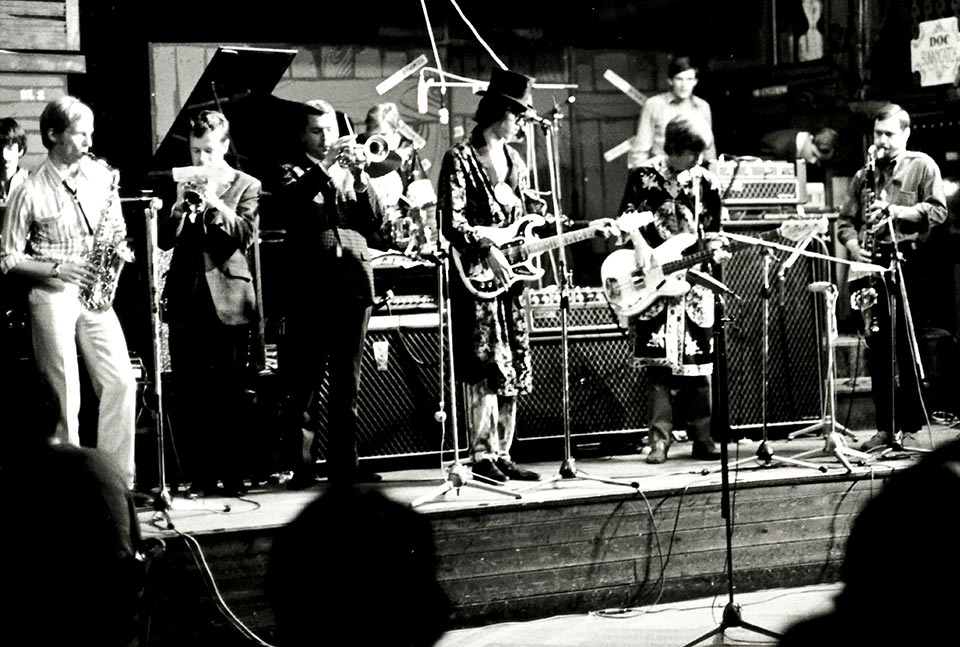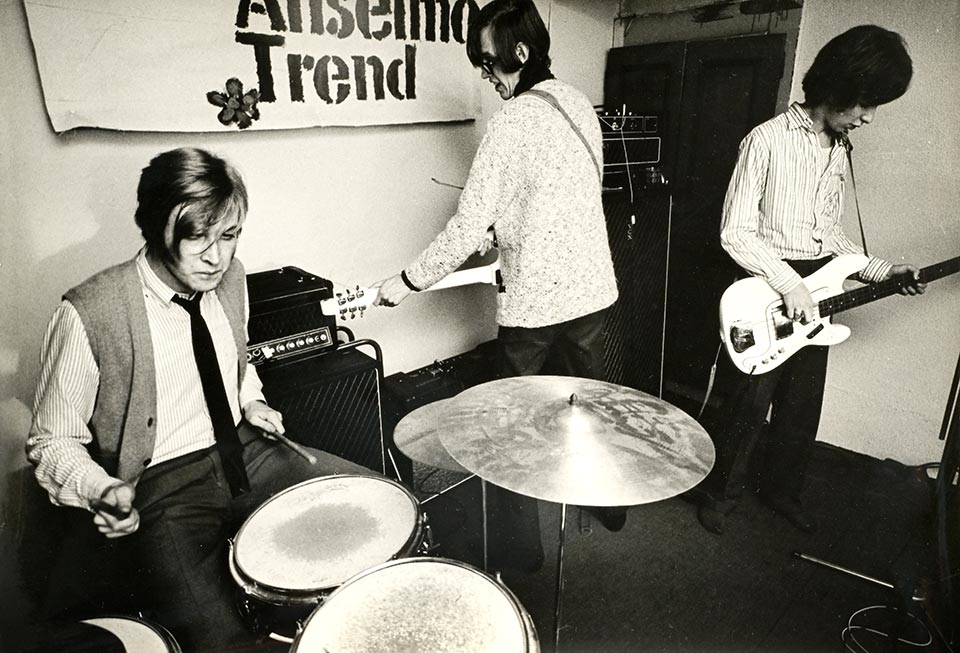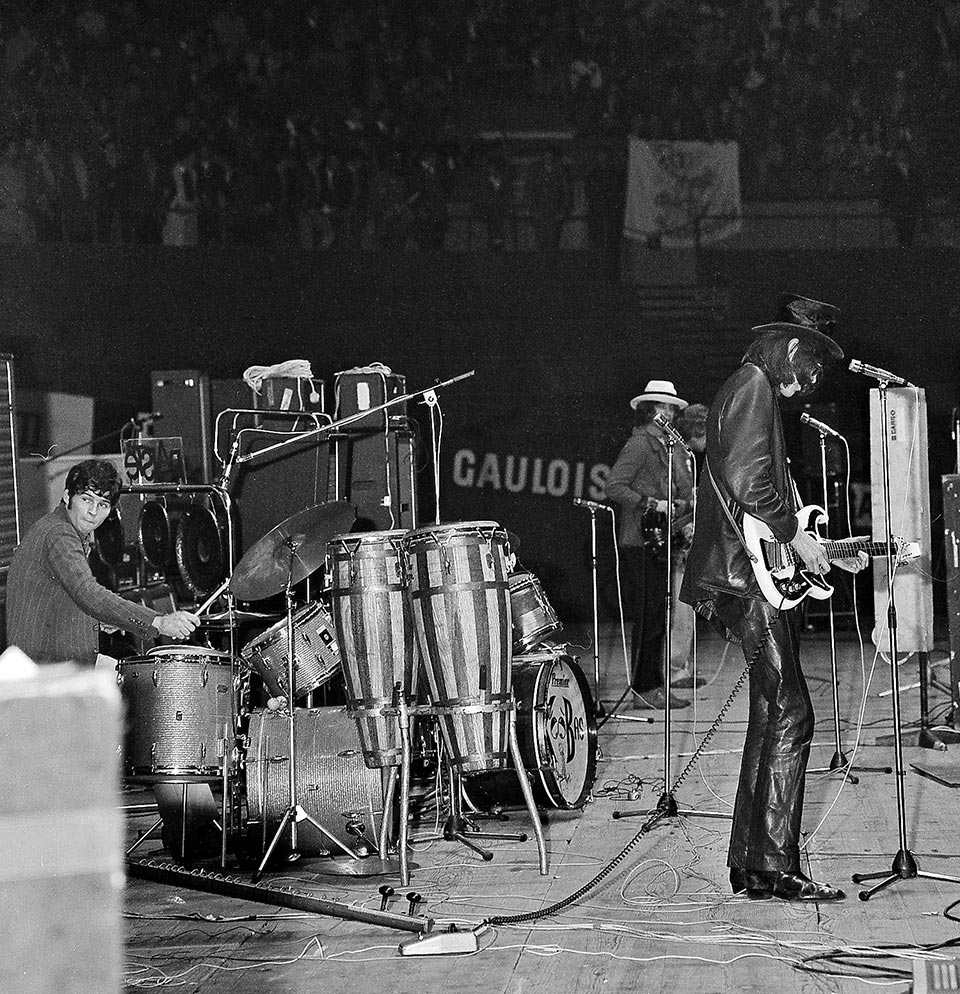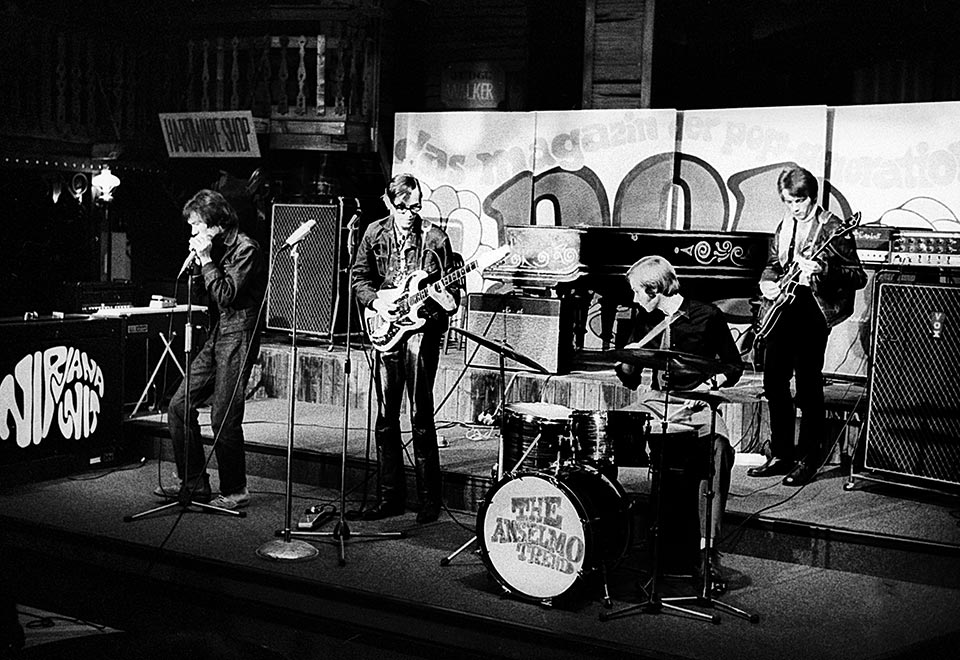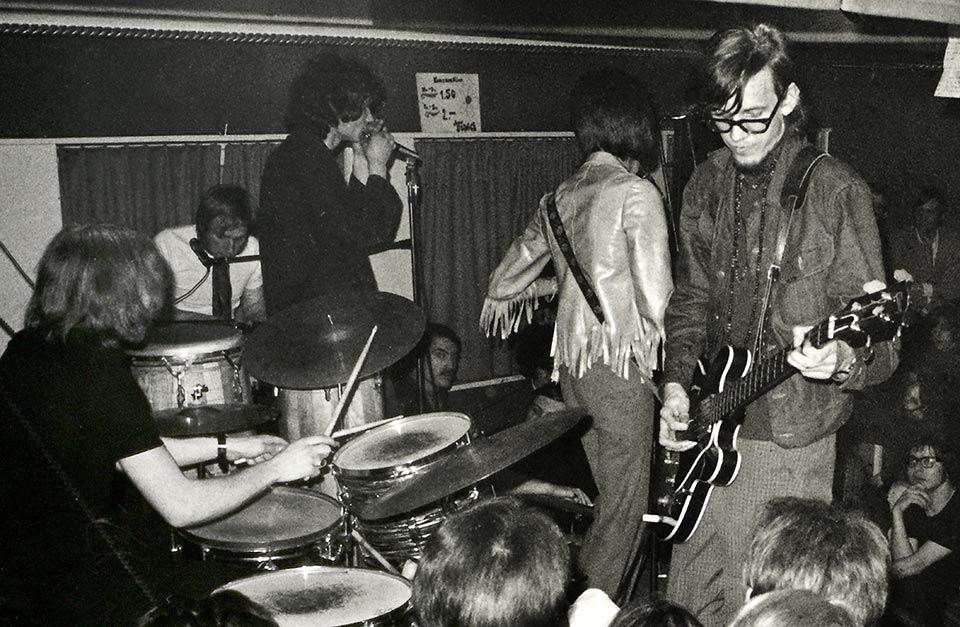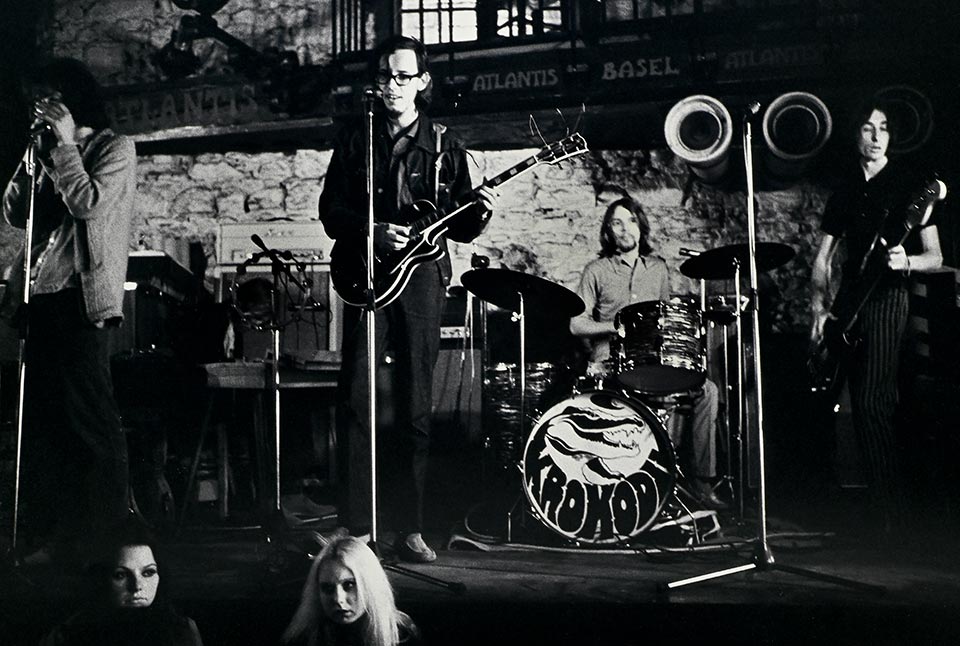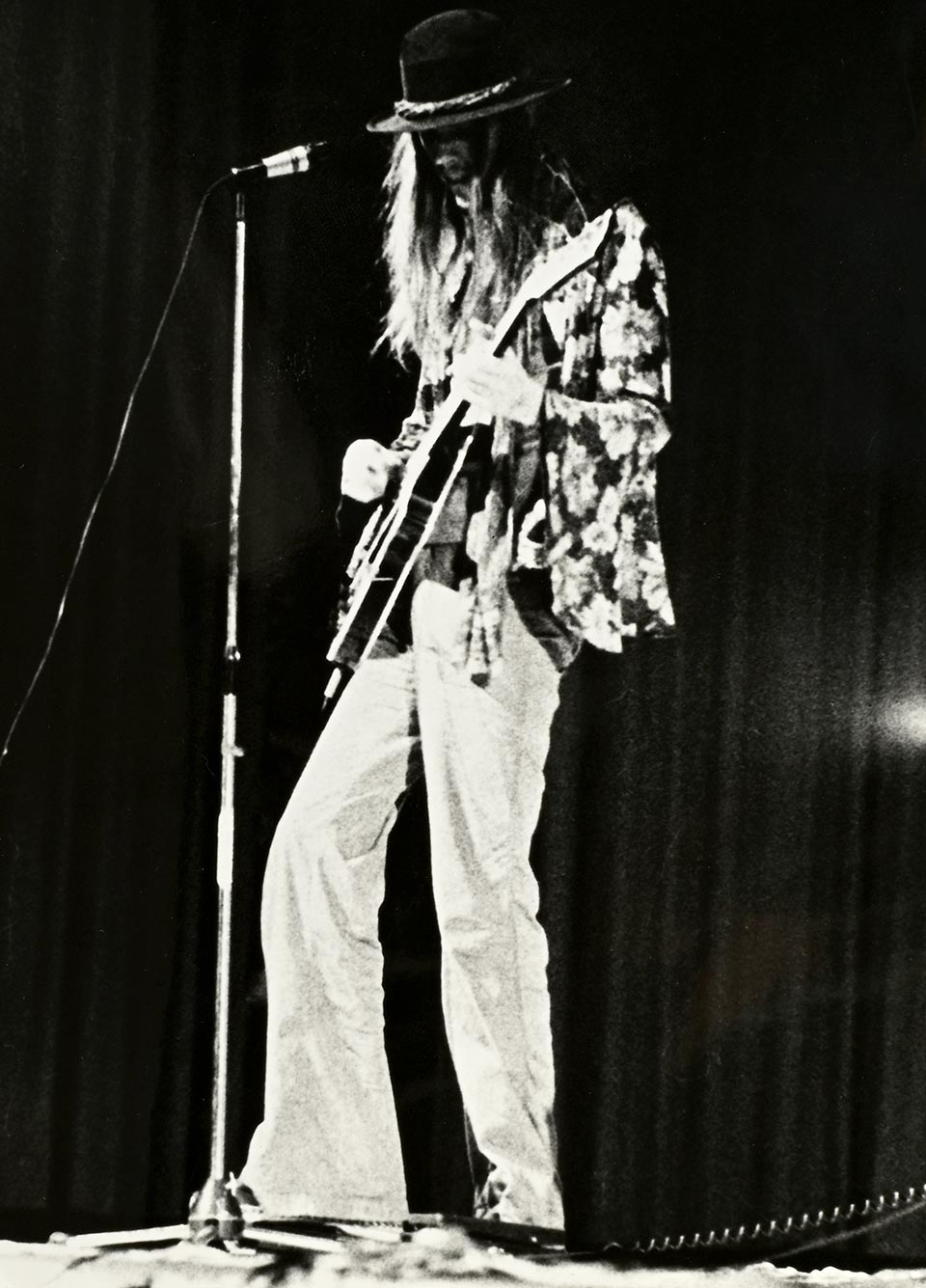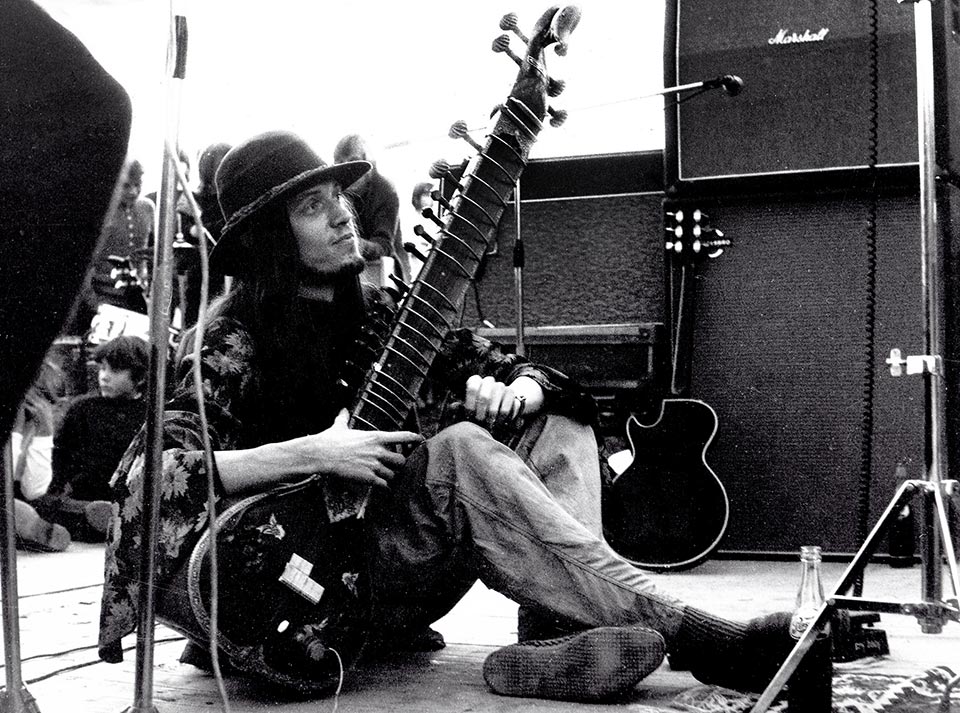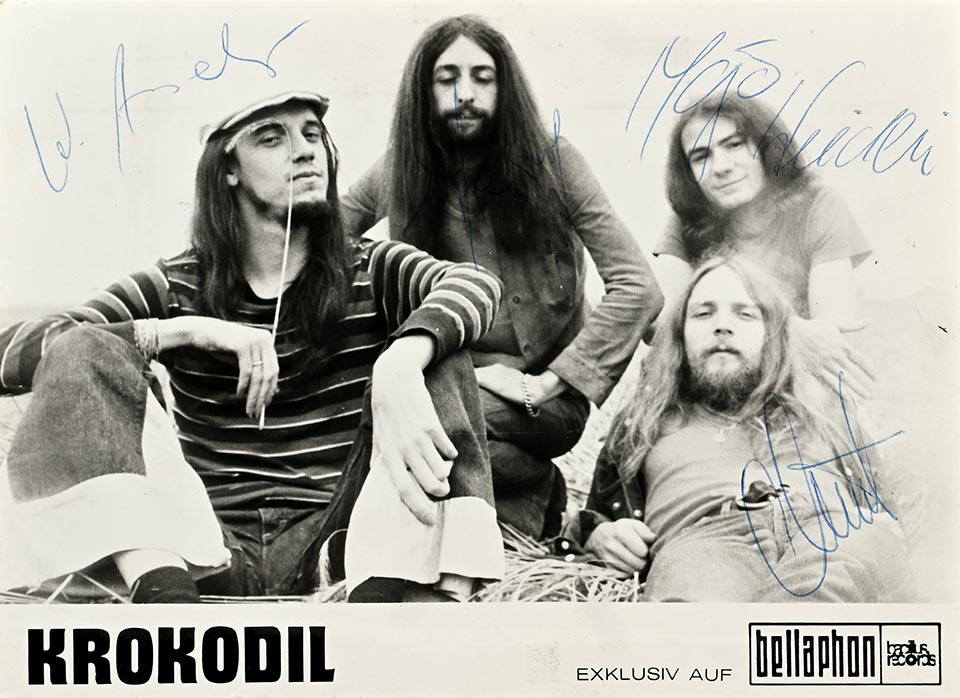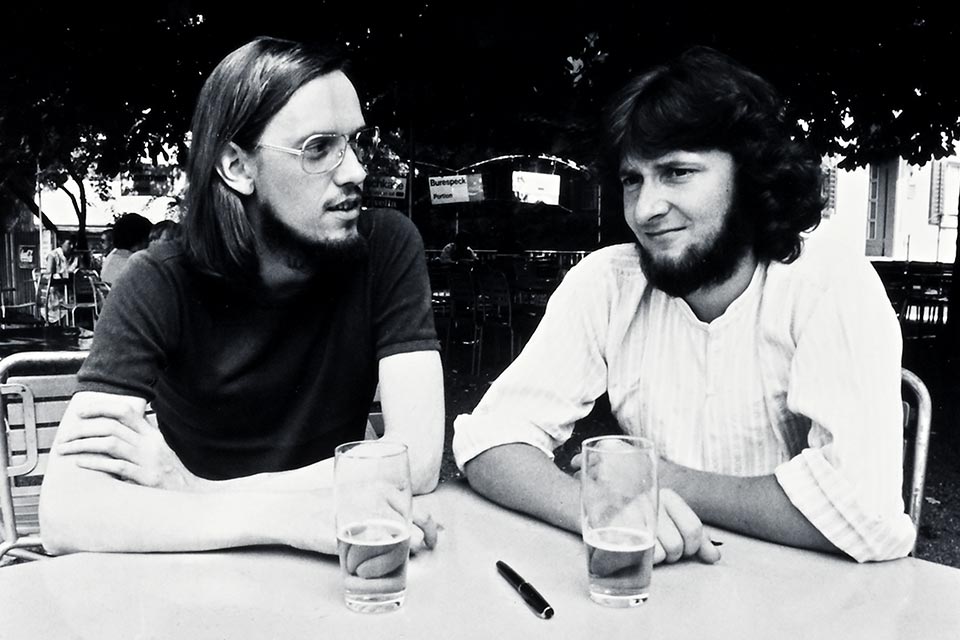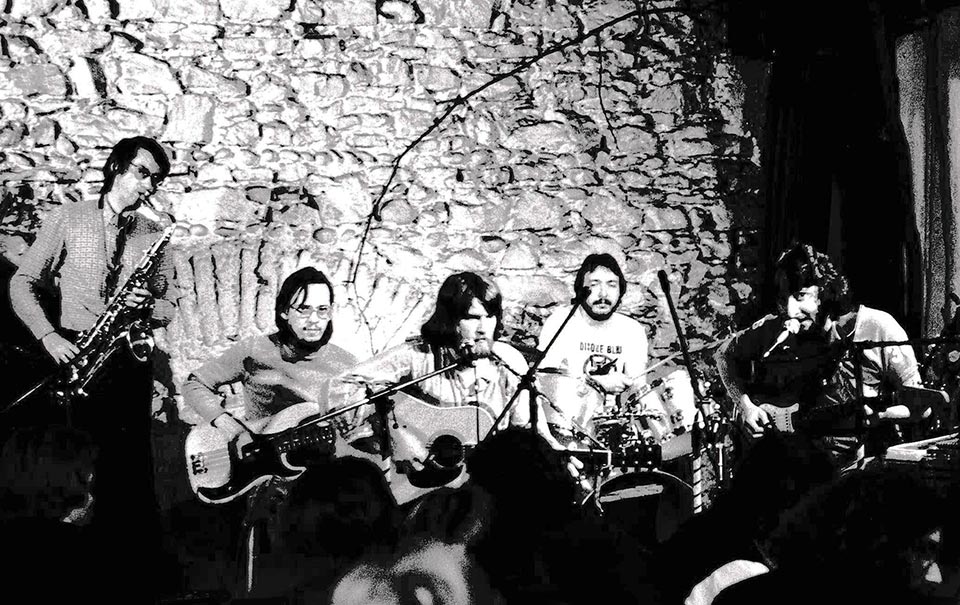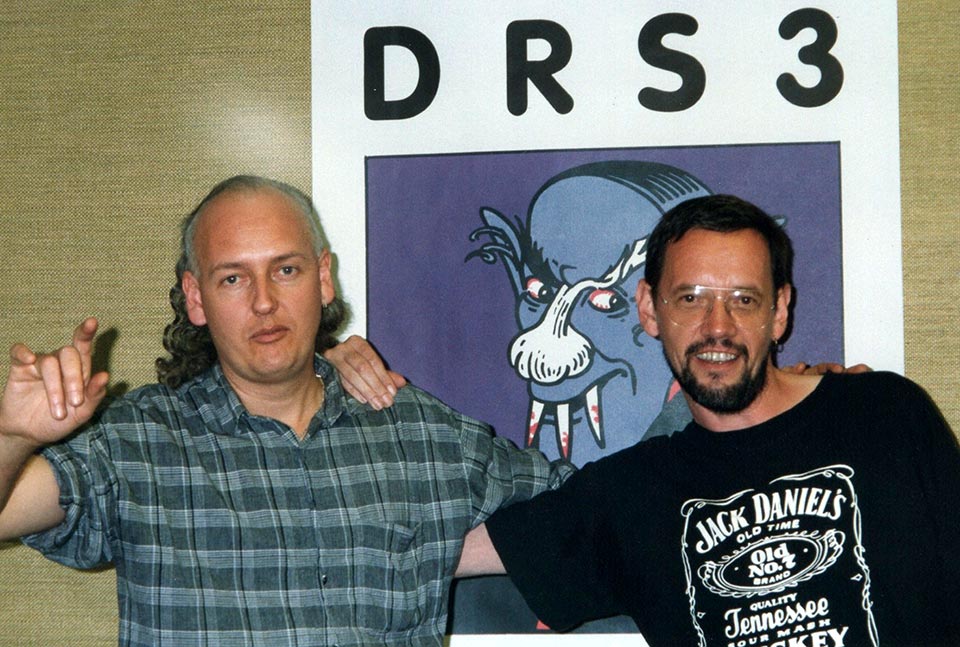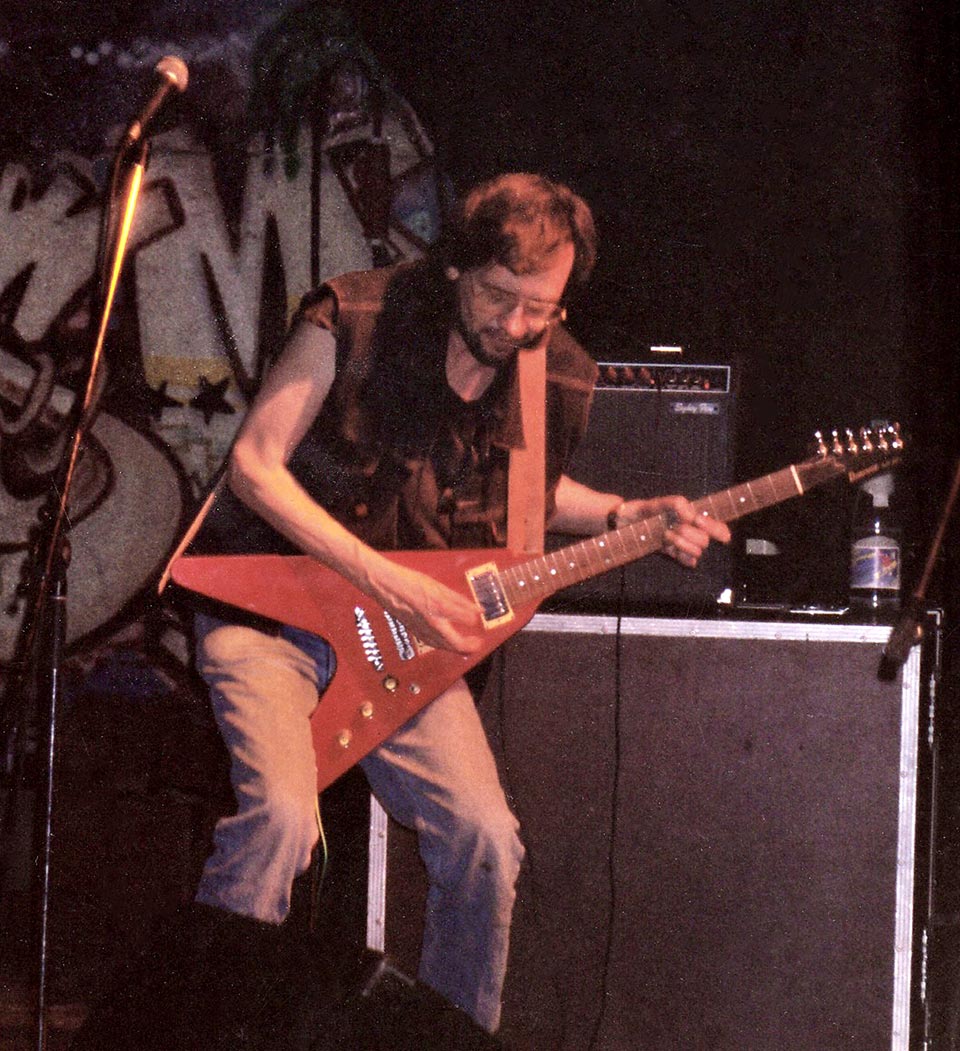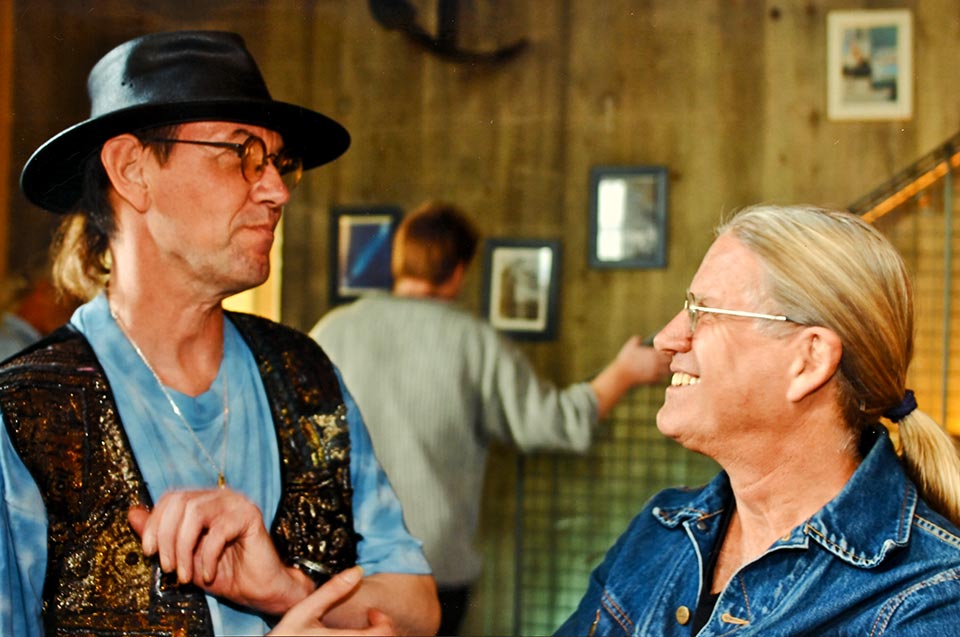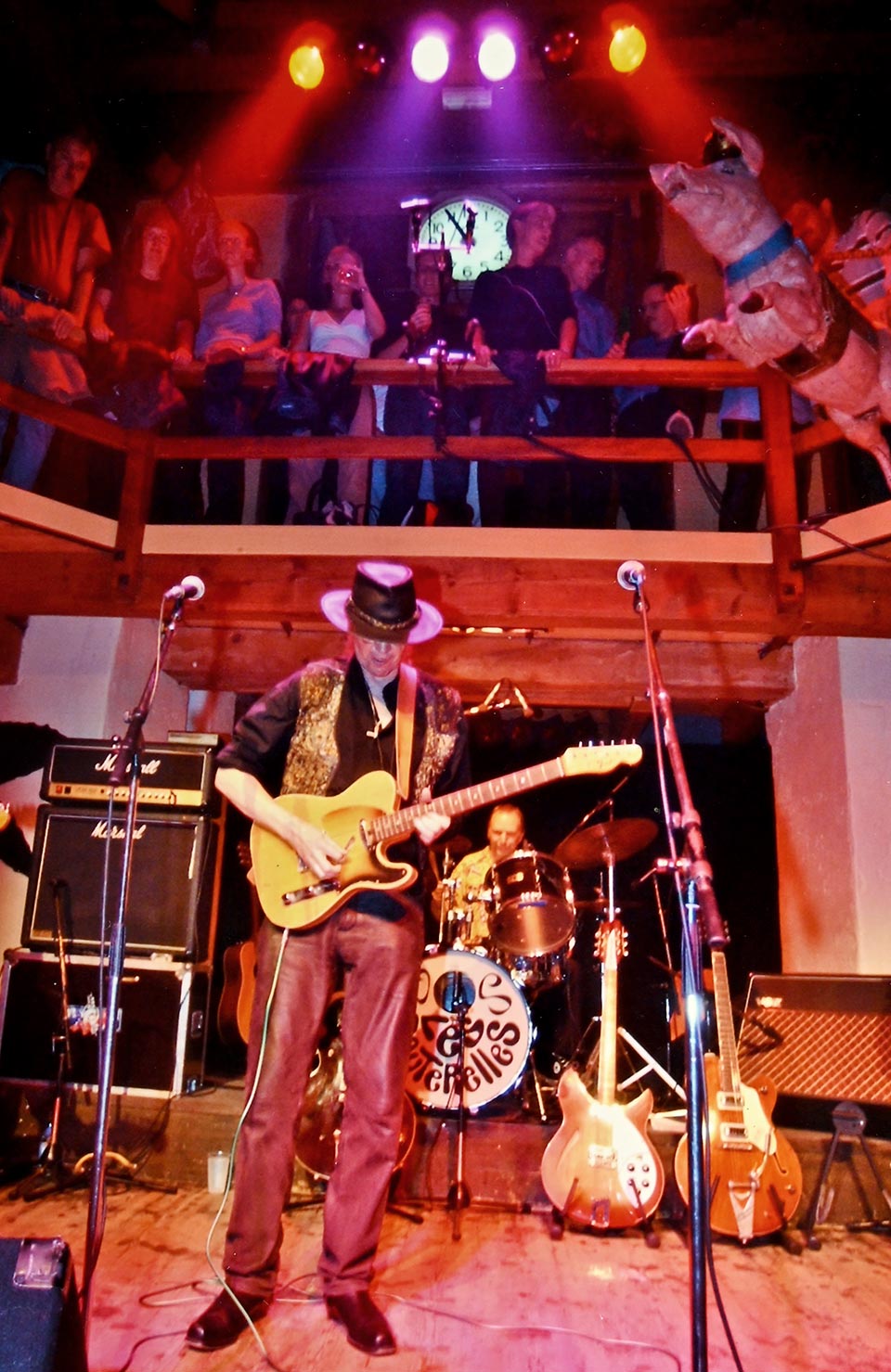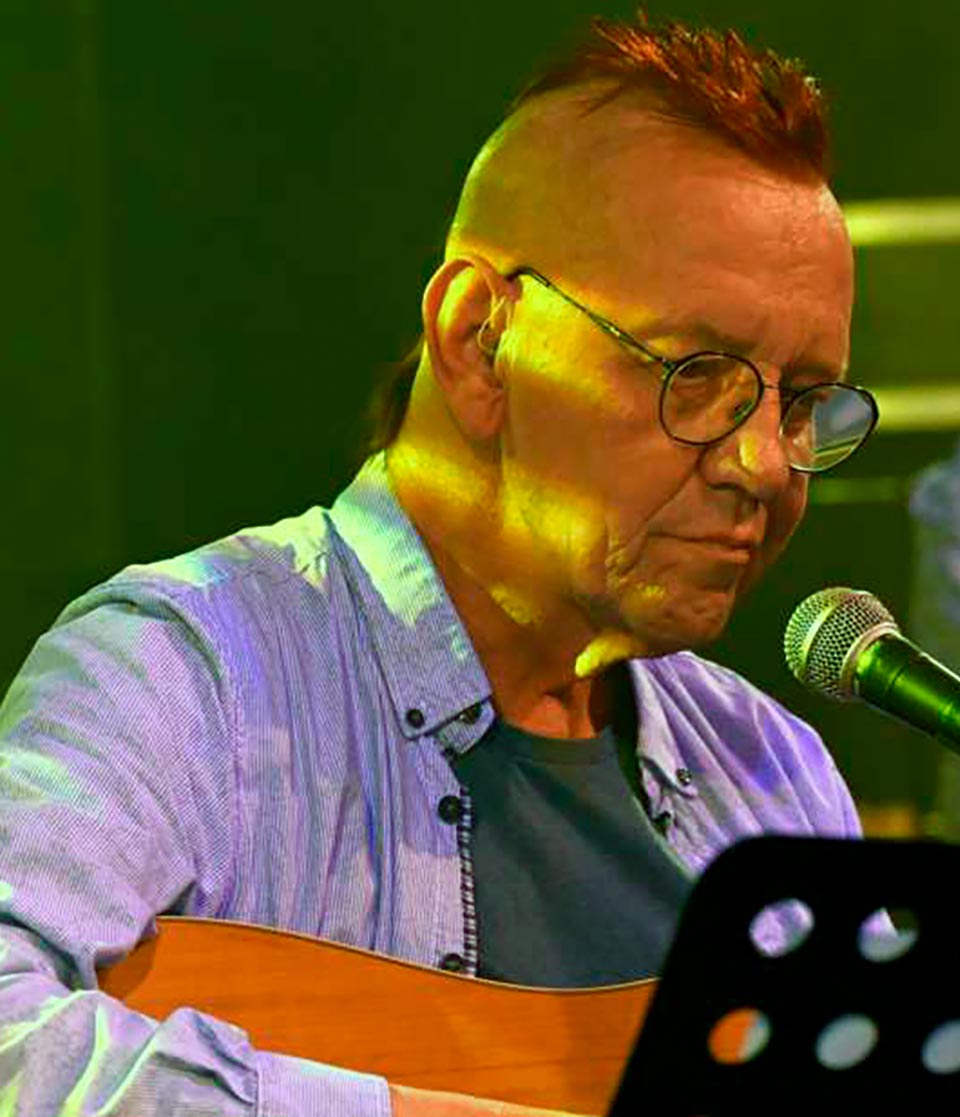YOUNGBLOOD
Walty Anselmo, ca. 1962, mit strengem Kurzhaarschnitt und fescher Stromgitarre.
Portrait of the young man as an artist, 1962.
WEST STREET QUARTETT
Auf Tanzmusikkurs: Waltys erste Band, das West Street Quartett, mit Walty Anselmo, Kurt Vienny, Hanspeter Sterchi und René Tiefenthaler, Zürich 1963.
Zurich 1963: Walty Anselmo’s first dance band was called the West Street Quartet. Walty is on the left, spotting a rocker haircut and an electric guitar.
TWIST NUR TWIST
Der neue Sänger Roger „Pichi“ Bollier (vorne) kniet sich voll rein.
The band with new singer Roger „Pichi“ Bollier, a schlager prodigy and born showman.
PICHI AND HIS LIMELIGHT
Im selben Boot: Autogrammkarte von Pichi and his Limelight, 1964.
A 1964 autograph card for Pichi and his Limelight, 1964.
READY FOR TAKE OFF
Filmaufnahmen für einen (verschollenen) Scopitone Film (wohl für Pichis Single „Null Uhr Zehn“).
On the set for a promo film, which sadly has been lost.
SCHLAGERFESTIVAL KREUZLINGEN
Am Schlagerwettbewerb in Kreuzlingen räumen Pichi and his Limelight 1963 mit juvenilem Schalk und geballter Rock’n’Roll-Energie ab. Das Schweizer Fernsehen filmt - und ist der Band wohlgesinnt.
At the „Schlager“ contest in Kreuzlingen, near the German border, Pichi and the Limelight were a huge success. This was due to their highly energetic Rock and Twist show, not very common in the Switzerland of 1963. Their set was filmed by Swiss TV.
HELLFIRE IM LONGSTREET
Toni Vescoli
Im Sommer 1964 debütieren The Hellfire im legendären Longstreet an der Zürcher Langstrasse. Pichi wird herauskomplementiert. Jetzt spielt die Band ohne ihn neben Shadows-Instrumentals auch erste Beatles-Songs und Walty übt sich im Yeah-Yeah-Schreien. Auch hier taucht das Fernsehen auf, um die Euphorie um die Schweizer „Hilfs-Beatles“ zu dokumentieren.
In the summer of 64 the times they were a-changin’. Pichi was fired and the band continued under the new name of The Hellfire. Walty was the new singer, twisting and shouting. The Hellfire were still great fans of The Shadows, but they also had some frantic Beatles covers in their set, that attracted the attention of young Beat music fans. Swiss TV again was present, reporting about the „second class Beatles“ from Zurich.
FENDER-BENDER
Andreas Wolfensberger
Walty Anselmo im Frühjahr 1965 bei einem Aufritt in Glattbrugg bei Zürich. Er ist einer der ersten, der in Zürich auf einer Fender Stratocaster spielt.
Walty Anselmo plays his Fender Strat, Zürich, spring 1965.
SHADOWS-KONZERT 1965
Walty Anselmo und ein Kollege in den Rängen des ersten grossen Rockkonzerts im Zürcher Hallenstadion, 14. August 1965. Auch wenn Walty noch für The Shadows schwärmt, belegt der eher magere Publikumsaufmarsch, dass sie von den Beatles überholt werden.
Walty and a friend at the Hallenstadion Zurich, where the first big Rock concert in Switzerland took place. Headliners were British instrumental band The Shadows, but their star was sinking and Beatlemania was arriving in Switzerland. This may have the reason, why the stadium was also half full.
WALKIN’ ON THIS ROAD
Walty 1965 mit seinem Freund Hardy (damals noch Heiner) Hepp auf folkigen Pfaden. Die elektrische Gitarre hat er verkauft.
In 1965 Walty Anselmo sold his electric guitar and went acoustic. His partner was the singer and music-scene-insider Hardy Hepp.
HEPP ANSELMO
Ernst Wirz
Promofoto für das Duo Hepp Anselmo, das sich früher auch The Peregrines nannte. Hinter der Kamera steht der Grafiker und Musiker Ernst Wirz, der später auch die Coverfotos für das erste Sauterelles-Album schiesst.
An early promo photo of Hepp Anselmo by Ernst Wirz.
HITCHHIKING
Beat Hirt
Hepp Anselmo auf dem Weg nach Paris, Sommer 1966.
Hepp Anselmo on their way to Paris, Summer 1966.
LONDON 1966
Beat Hirt
1966 versuchen Hepp Anselmo als trampende Folkies in der Londoner Szene Fuss zu fassen. Leider ohne Erfolg.
In 1966, Hepp Anselmo travelled to London and hoped for an international breakthrough. But nobody in the capital of Beat music had waited for two Swiss Folkies.
PLEASE PLEASE US
Hepp Anselmo stellen in London das Cover der ersten Beatles-LP „Please Please Me“ nach.
In London, Hepp Anselmo tried to imitate the cover shot of „Please Please Me“ by The Beatles.
NO SATISFACTION
Walty Anselmo (hinten, in Konfirmandenschale) begleitet Hardy Hepp im Vorprogramm des esten Schweizer Konzertes der Rolling Stones, 14. April 1967. Auf dem Programm steht Soul, der Sound von 1967 - sogar „Satisfaction“ bringen sie in der Otis-Redding-Version. Doch die Fans im ausverkauften Zürcher Hallenstadion pfeifen ihre Lokalmatadoren gnadenlos aus.
In 1967, Walty plugged in again. He and his friend Hardy Hepp brought together a Soul Revue, when supporting the Rolling Stones at their Swiss concert debut at the Hallenstadion Zurich, April 14 1967. They even played the Otis Redding version of „Satisfaction“. But the Stones fans were cruel and booed the hip supporting act off the stage.
FLOWER POWER FESTIVAL
Der Summer of Love wird in Zürich autonom nachvollzogen. Im September 1967 trifft sich die Zürcher Szene zu einem „Love In“ auf der Allmend. Für den passenden Sound ist das Anselmo Set besorgt.
In Switzerland, The Summer of Love began rather late. In September 1967 the Zurich hipsters and would-be-hippies organized an outdoor „love in“. The Anselmo set was playing the soulful and psychedelic soundtrack.
VORAUSSCHEIDUNGEN RHYTHM AND BLUES FESTIVAL
Beim Bandwettbewerb für das erste von der Zeitschrift „pop“ organisierte Rhythm and Blues Festival machen auch Walty Anselmo und sein Trio mit - und schwingen meist obenaus. Hier werden sie von „pop“-Chefredakteur Jürg Marquard zu den Siegern einer Vorausscheidung erklärt.
In 1967 Swiss music magazine „pop“ organized a Rhythm and Blues festival, which actually was a sort of competition for young talents. Walty Anselmo and his trio participated with success. On this pic, the trio is announced by Jürg Marquard, the editor in chief of „pop“-magazine.
HAZYLAND
Anselmo Trend am Finale des Rhyhtm and Blues Festivals im Zürcher Hazyland, 25. November 1967.
Anselmo Trend at the grande finale of the Rhythm and Blues Festival in Zürich’s Hazyland, November 25 1967.
ANSELMO TREND
Als Blues-Rock Trio auf den Spuren der Jimi Hendrix Experience treten Walty und Co. als „Anselmo Trend“ auf. Von links: Guido Fischer, Walty Anselmo und Martin Walder.
As a trio and under the name Anselmo Trend, Walty and his friends were heavily influenced by The Jimi Hendrix Experience. Left to right: Guido Fischer, Walty Anselmo, Martin Walder.
MONSTERKONZERT 30. MAI 1968
Stuart K. Richman / Courtesy of the Marcely Aeby collection
Walty Anselmo ist der einzige Schweizer Musiker, der sowohl bei den Hallenstadion-Konzerten der Rolling Stones und der Jimi Hendrix Experience auftritt. Am legendären Monsterkonzert mit Hendrix, Eric Burdon’s Animals, Traffic, The Move, John Mayall and the Bluesbreakers und The Koobas ist der Anselmo Trend die einzige Schweizer Band. Zuvor hat Walty Jimi Hendrix am Flughafen abgeholt und ist tief beeindruckt.
Walty Anselmo was the only Swiss musician, who played as an opening act at both legendary Zurich Rock concerts of the Sixties, The Rolling Stones (1967) and Jimi Hendrix + more (1968). Before the first show, Walty escorted Jimi Hendrix from the Zurich airport to town and was deeply impressed.
RHYTHM AND BLUES FESTIVAL 1968
Anselmo Trend spielen auch am zweiten „pop“-Rhythm and Blues Festival im Hazyland Zürich. Neu mit dabei ist der junge Blues-Harp-Spieler Kurt „Mojo“ Weideli, der Walty Anselmo später zum Krokodil folgt.
Anselmo Trend played also the second (and last) „pop“ Rhythm and Blues Festival at the Hazyland Zürich. Their new, young Blues harp player Kurt „Mojo“ Weideli later became a member of Krokodil.
KROKODIL DEBUT
Nach einer längeren Probephase tritt am 19. April 1969 die erste „richtige“ Schweizer Rock Band Krokodil auf die Bühne von Hans-Ruedi Jaggis „Blow Up“ Club. Die Zeiten des Kopierens sind vorbei. Krokodil wollen eigenständige, kreative Rockmusik spielen. Von links: Düde Dürst (er kommt von Les Sauterelles), Hardy Hepp, Mojo Weideli, Terry Stevens (von der englischen Band The Victors) und Walty Anselmo.
On April 19th 1969 Swiss rock band Krokodil played their first concert at the „Blow Up“ club in Zürich. They opted for an original, progressive Blues Rock Sound, instead of just copying current pop hits.
ATLANTIS BASEL
Eric Bachmann
Das Krokodil 1969 im renommierten Konzertlokal Atlantis in Basel, wo einst ein richtiges Krokodil zur Einrichtung gehörte.
Krokodil live at the legendary Atlantis club in Basel, where once a real crocodile had been part of the interior design.
GUITAR HERO
René Leutwyler
Als Gitarrist und als Songwriter erreicht Walty Anselmo bei Krokodil seinen Zenit. Sein expressiver Bluesrock-Stil ist unverwechselbar.
In Krokodil, Walty Anselmo was in the form of his life, as a guitarist as well as as a songwriter and singer.
SITAR MAN
René Leutwyler
Seit 1968 spielt Walty Anselmo auch die indische Sitar. Einmal wurde er mit seiner Sitar für einen Werbespot eingeladen. Er war noch am Stimmen, als ihm der Aufnahmeleiter beschied, die Aufnahme sei im Kasten, er könne wieder gehen.
Since 1968 also played the Sitar.
OPEN AIR
In Deutschland spielen Krokodil an Festivals in grossen Stadien und - auch in der Schweiz - an Openairs im Woodstock-Stil.
In Germany, Krokodil were a top act, playing festivals in stadiums or open air - Woodstock style.
AUTOGRAMMKARTE 1972
Ende 1970 verlässt Hardy Hepp das Krokodil, 1972 verliert die Band ihren Plattenvertrag mit Liberty / United Artists. Krododil wechseln zu Bellaphon. Aus dieser Zeit stammt diese Autogrammkarte.
In 1970 Hardy Hepp left the band, in 1972 they lost their record deal with Liberty/United Artists. They then changed to German company Bellaphon. Here’s a fully signed autograph card from this period.
WALTY ANSELMO & MAX LÄSSER
René Leutwyler
Nach der Auflösung von Krokodil wechselt Walty Anselmo wieder zu folkigeren Sounds. Mit dem Gitarristen Max Lässer ist er regelmässig im Duo unterwegs. Walty spielt nun vermehrt Bass.
After Krokodil disbanded Walty Anselmo changed to more folky sounds, often playing the bass. He had a duo with guitar player Max Lässer.
IM BODE BAND MIT WALTER LIETHA
1977 gesellen sich Walty Anselmo und Max Lässer zur Im Bode Band des Bündner Liedermachers Walter Lietha. Dieses Bild stammt von einem Konzert im Burgbachkeller in Zug, Dezember 1976. Von links: Bruno Spoerri, Walty Anselmo, Walter Lietha, Walter Keiser, Max Lässer.
In 1976 Walty Anselmo and Max Lässer joined the Im Bode Band of singer/songwriter Walter Lietha (from Chur, Grisons). They played a mixture of styles and also had the jazz saxophonist (and electronic music pioneer) Bruno Spoerri in their line up.
IM BODE BAND OPEN AIR BACHTEL
Die Im Bode Band an zahlreichen Folk-Festivals, so 1978 auch am Festival auf dem Zürcher Bachtel.
Im Bode Band 1978 at the Bachtel Folk Festival in Zurich.
WALTY UND GOGO
In den 1980ern zieht sich Walty Anselmo aus der Musikszene zurück. Doch später, an seinem neuen Wohnort Aarau, greift er wieder zur Gitarre. In der Band Highrise um den umtriebigen Lokalmatadoren Gogo Frei spielt er an der Seite seines alten Kumpels Jelly Pastorini wieder oft live in alternativen Szeneschuppen und an Parties. 1993 sind Highrise im Studio von DRS 3 für einen „Summer Session“.
In the Eighties Walty quit the music business. But about ten years later he joined the Band Highrise in Aarau, that was lead by local hero Gogo Frei and also featured Walty oldime buddy Jelly Pastorini, one of the most original players of the Sixties, on keyboards.
FLYING
Walty Anselmo im Bieler Gaskessel, frühe Neunzigerjahre, mit Flying V Gitarre.
Walty with his Flying V in Biel/Bienne, early 1990’s.
MILLENNIUM
Ein punkiger Walty grüsst seine Freunde an der Wende vom 20. zum 21. Jahrhundert
Walty started the new millennium in a punky mood.
WALTY UND TONI
Urs Graf
Walty Anselmo im Gespräch mit seinem einstigen Bewunderer und Swiss Beatle Toni Vescoli an der Vernissage zu Sams erstem Buch „BeatPopProtest“ 2001 im El Lokal in Zürich. Walty und sein Wegbegleiter Hardy Hepp sind special guests an einem exklusiven Konzert von Les Sauterelles.
Toni Vescoli, the leader of the Swiss Beatles Les Sauterelles had been an early admiror of Walty in the Sixties. In 2002, the pair reunited a the launch of Sam’s Book „BeatPopProtest“.
MÜHLE HUNZIKEN
Urs Graf
Walty bei der zweiten Buchvernissage in der Mühle Hunziken, 2001. Für den Backbeat sorgt sein altes Mit-Krokodil Düde Dürst.
Walty onstage in 2002, backed by Les Sauterelles and his former Krokodil band mate Düde Dürst on drums.
RUSTY REPTILES
Eine von Walty Anselmos späten Bands sind The Rusty Reptiles. Hier bei einem Auftritt im Zürcher Falcone Club, Februar 2016. Von links Walty Anselmo, Matt Graf, Terry Stevens.
The Rusty Reptiles were one of the bands of Walty Anselmo’s later days. Here’s a live pic from 2016, featuring Walty, drummer Matt Graf and Terry Stevens, who had been in Krokodil together with Walty.
THE LAST WALTZ
Ein gesundheitlich angeschlagener aber charismatischer Walty Anselmo spielt und singt am 10. September 2021 als „ special guest“ sein letztes Konzert in der Kaserne Zürich, das gleichzeitig das erste der wieder auferstandenen Krokodil um Drummer Düde Dürst ist.
A rather fragile but charismatic Walty Anselmo played his last show as a „special guest“ at the Kaserne in Zürich, 10th September 2021. This was also the first show of the „new“ Krokodil, led by drummer Düde Dürst.
